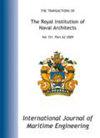LOADING RESPONSE OF STERN TAB MOTION CONTROLS IN SHALLOW WATER
IF 0.6
4区 工程技术
Q4 ENGINEERING, MARINE
引用次数: 1
Abstract
The ride control systems of high-speed vessels frequently use active stern tabs for both motion control and maintenance of correct trim at various speeds and sea conditions. This paper investigates the effect of water depth on the lift force provided by stern mounted trim tabs, of the type fitted to INCAT high speed wave-piercer catamaran vehicle ferries and similar vessels. This investigation was carried out at model scale with the use of a test apparatus in a flume tank in the University of Tasmania hydraulics laboratory. The lift force magnitude and location were measured over a range of tab angles and flow depths. This was used to calculate the lift coefficient of the tab and asses the performance of the tab over the range of flow depths. It was found that the lift force increased and the force location progressed further forward of the hinge as flow depth decreased. The lift curve slope of the stern tab increased by a factor of over 3 relative to the deep water value when the water depth below the hull was approximately equal to the tab chord. The deep water lift curve slope appears to be approached only when the water depth exceeded 4 or more tab chord lengths. The centre of pressure of the lift force was more than two chord lengths ahead of the tab hinge, showing that most of the lift produced by the tab was under the hull rather than on the surface of the tab itself.浅水条件下尾板运动控制器的载荷响应
高速船舶的航行控制系统经常使用主动船尾标签来控制运动,并在各种速度和海况下维护正确的配平。本文研究了水深对安装在INCAT高速穿波双体船轮渡和类似船只上的船尾饰板所提供的升力的影响。这项研究是在塔斯马尼亚大学水力学实验室的水槽水槽中使用测试设备进行的。升力的大小和位置在不同角度和流动深度范围内进行了测量。这被用来计算膜片的升力系数,并评估膜片在流动深度范围内的性能。研究发现,随着流动深度的减小,升力增大,力的位置进一步向前推进。当船身以下水深近似等于艉板弦时,艉板的升力曲线斜率相对于深水值增加了3倍以上。深水抬升曲线斜率只有在水深超过4个弦长时才会接近。升力的压力中心在船板铰链前面超过两个弦长,这表明大部分由船板产生的升力是在船体下面,而不是在船板本身的表面上。
本文章由计算机程序翻译,如有差异,请以英文原文为准。
求助全文
约1分钟内获得全文
求助全文
来源期刊

International Journal of Maritime Engineering
ENGINEERING, MARINE-
CiteScore
1.20
自引率
0.00%
发文量
18
审稿时长
>12 weeks
期刊介绍:
The International Journal of Maritime Engineering (IJME) provides a forum for the reporting and discussion on technical and scientific issues associated with the design and construction of commercial marine vessels . Contributions in the form of papers and notes, together with discussion on published papers are welcomed.
 求助内容:
求助内容: 应助结果提醒方式:
应助结果提醒方式:


